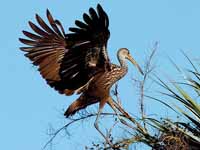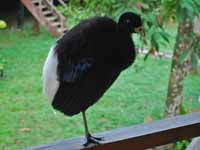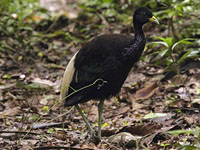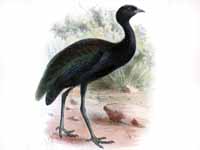THE WORLD BIRDS - An Online Bird Book
GRUIFORMES
Family Aramidae: Limpkins
GRUIFORMES
Gruiformes means "crane-like", The order include 14 species of large cranes, about 145 species of smaller crakes and rails, as well as a variety of families comprising a small number of species.
Guiformes has the following families
Guiformes has the following families
Family Aramidae: Limpkins
This family only has one species. It is found mostly in wetlands in warm parts of the Americas, from Florida to northern Argentina. It feeds on mollusks. The male and females look alike, however the males are slightly larger. The limpkin's call is loud and scream-like.
Genus Aramus - 1 species
Limpkin Aramus guarauna
Description: The limpkin has brown upperparts with a greenish shine and small white shreeks. It has a long neck and long legs. The shape of its bill enables the limpkin to remove snails from their shells.The name reflects the limp it seems to have when walking. Its call is a loud scream which can help a birder locate the species.The limpkin is 64 to 73 cm long. The similar juvenile glossy ibis is darker and its bill is more curved than limpkin's.
Range: Florida and Mexico to Argentina; also Caribbean.
Habitat: Semi-tropical and tropical wetlands.
Diet: Snails and freshwater mussels
Conservation status: Least Concern.
Image by: 1) Adubin 2, 3 Dick Daniels - Lake Okeechobee, Florida 4, 6) Dick - Lake Okeechobee 5) Leppyone Range: Florida and Mexico to Argentina; also Caribbean.
Habitat: Semi-tropical and tropical wetlands.
Diet: Snails and freshwater mussels
Conservation status: Least Concern.
1) Juvenile 6) With an Osprey






Order Gruiformes Family Psophiidae - 1 genus
This family has 3 species. They are named for the trumpeting call of the males. They are dumpy birds with long necks and legs and curved bills and a hunched posture. Their heads are small, but their eyes are relatively large, making them look "good-natured". They forage on the forest floor with a first choice of fallen fruits, a second choice of insects, and they occasionally eat carrion.
Trumpeters are very social and also territorial. If the group's territory is entered by another trumpeter group, the home team will try to drive them off. The encounter usually results in some fighting between the males. The home group usually wins the encounter and the defeated trumpeters exhibit submissive behavior.
Genus Psophia
Trumpeter, grey-winged Psophia crepitans Found: South America
Description: The grey-winged trumpeter has a mainly dark body with chestnut on its mantle and pale grey on its rear and folded wings. It has a hunched-back shape. The yellow bill is short and chicken like. grey-winged trumpeters are sociable and may have flocks of 50, but that shrinks to about 5 during the breeding season. The entire group shares incubation duties. Their nest is in a hollow tree. Its call is loud and honking which leads to its name. The grey-winged trumpeter is easily tamed and its loud alerting call leads to it being kept as a pet sentinel.
Range: South America in the region of the Amazon.
Habitat: Forest floor.
Diet: Insecs, fruits. They forage while on the ground and prefer to run rather than fly.
Conservation status: Least Concern.
Image by: 1) Dick Daniels - Sylvan Heights 2, 3) Dick - the Jacksonville Zoo, Florida 4) Sandy Cole - National Aviary Range: South America in the region of the Amazon.
Habitat: Forest floor.
Diet: Insecs, fruits. They forage while on the ground and prefer to run rather than fly.
Conservation status: Least Concern.




Trumpeter, Pale-winged Psophia leucoptera
Description: The pale-winged trumpeter is very similar to the grey-winged trumpeter, but its wings and rear are even paler. The pale-winged trumpeter is about 50 cm long. Their nest is in the hollow of a free about 10 meters off the ground. In spite of that height, the one day old chicks jump to the ground and follow the adults.
Range: Northwest Brazil, northern Bolivia, and eastern Peru.
Habitat: Humid tropical forests where it forages on the forest floor.
Diet: Mainly fruit that has fallen to the forest floor. Also insects and some dead snakes.
Conservation status: It is listed as Near Threatened because of habitat destruction, but in remote areas there still seems to be a substantial population.
Image by: 1) Ajvhan - Peru 2) Jerry Villone - Peru 3) Arthur Chapman - Peru 4) Joe_TobiasRange: Northwest Brazil, northern Bolivia, and eastern Peru.
Habitat: Humid tropical forests where it forages on the forest floor.
Diet: Mainly fruit that has fallen to the forest floor. Also insects and some dead snakes.
Conservation status: It is listed as Near Threatened because of habitat destruction, but in remote areas there still seems to be a substantial population.
3) grey-winged trumpeter in foreground, pale-winged trumpeter in background.




Trumpeter,_Dark-winged Psophia viridis Found: rainforest of Brazil
Description: Unlike the other members of the genus, the dark winged trumpeter's upperparts are mostly uniform. For one subspecies, the upperparts are green, for the other they are dark brown,
Range: Southeast and south-central Amazonia, only in Brazil.
Habitat: Rainforest.
Diet: Fruit, insects, carrion.
Conservation status: It is listed as Vulnerable as it prefers primary forest far from civilization some of which are being cleared. Also, they are hunted for food.
Image by: 1) John Keulemans 2) Nick Athanas 3) Joao_QuentalRange: Southeast and south-central Amazonia, only in Brazil.
Habitat: Rainforest.
Diet: Fruit, insects, carrion.
Conservation status: It is listed as Vulnerable as it prefers primary forest far from civilization some of which are being cleared. Also, they are hunted for food.


